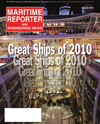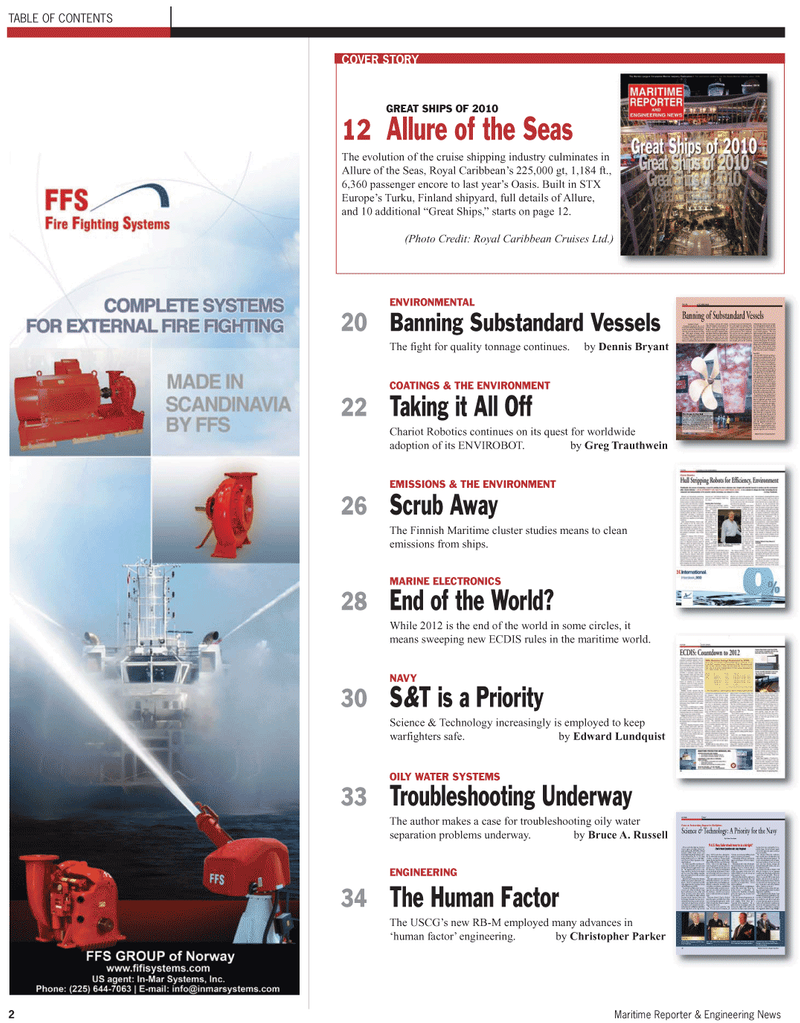
Page 2: of Maritime Reporter Magazine (December 2010)
Great Ships of 2010
Read this page in Pdf, Flash or Html5 edition of December 2010 Maritime Reporter Magazine
COVER STORY
GREAT SHIPS OF 2010 12 Allure of the Seas
The evolution of the cruise shipping industry culminates in
Allure of the Seas, Royal Caribbean’s 225,000 gt, 1,184 ft., 6,360 passenger encore to last year’s Oasis. Built in STX
Europe’s Turku, Finland shipyard, full details of Allure, and 10 additional “Great Ships,” starts on page 12. (Photo Credit: Royal Caribbean Cruises Ltd.) 2 Maritime Reporter & Engineering News
TABLE OF CONTENTS
ENVIRONMENTAL 20 Banning Substandard Vessels
The fight for quality tonnage continues. by Dennis Bryant
COATINGS & THE ENVIRONMENT 22 Taking it All Off
Chariot Robotics continues on its quest for worldwide adoption of its ENVIROBOT. by Greg Trauthwein
EMISSIONS & THE ENVIRONMENT 26 Scrub Away
The Finnish Maritime cluster studies means to clean emissions from ships.
MARINE ELECTRONICS 28 End of the World?
While 2012 is the end of the world in some circles, it means sweeping new ECDIS rules in the maritime world.
NAVY 30 S&T is a Priority
Science & Technology increasingly is employed to keep warfighters safe. by Edward Lundquist
OILY WATER SYSTEMS 33 Troubleshooting Underway
The author makes a case for troubleshooting oily water separation problems underway. by Bruce A. Russell
ENGINEERING 34 The Human Factor
The USCG’s new RB-M employed many advances in ‘human factor’ engineering. by Christopher Parker by Dennis L. Bryant
Customary international law, as evi- denced in the United Nations Convention on the Law of the Sea (UNCLOS) pro- vides for reasonable freedom of naviga- tion. With regard to foreign vessels wishing to enter the ports or territorial sea of a nation, UNCLOS provides that the coastal nation may adopt laws and regu- lations, in conformity with international law, relating to (among other things) safety of navigation and prevention of pollution. These laws and regulations, though, shall not apply to the design, con- struction, manning, or equipment of for- eign ships unless they are giving effect to generally accepted international rules or standards. Port states have very clear rights (indeed, obligations) under various international conventions to exercise con- trol measures, up to and including deten- tion, with respect to any foreign vessel voluntarily in its waters the condition of which does not correspond substantially with the particulars of its certificates.
The rules are less clear regarding the right of the port state to keep out (i.e., ban) from its waters a foreign vessel that wishes to make entry. Various port states have adopted protocols for examining visiting foreign vessels to ensure compli- ance with applicable domestic and inter- national requirements. These protocols are commonly referred to as port state control (PSC) programs. The most highly developed of the various national
PSC programs is administered by the US
Coast Guard. Many regional groupings have also been organized by port states to coordinate PSC programs. The two lead- ing such regional groupings are the Paris
Memorandum of Understanding (MOU) on Port State Control and the Tokyo
MOU. Others exist in Latin America, the
Black Sea, and the Arabian Gulf regions.
Paris MOU
The Paris MOU includes specific pro- visions for access refusal measures. Ves- sels subject to refusal of access consist of: (1) gas and chemical tankers; (2) bulk carriers; (3) oil tankers; and (4) passen- ger ships. Port state control authorities in a member state are to ensure that a ship in any of these categories is refused ac- cess if the ship either: (a) flies the flag of a state appearing on the Paris MOU black list and has been detained more than twice during the preceding 24 months in a Paris MOU port; or (b) flies the flag of a state described as “very high risk” or “high risk” by the Paris MOU and has been detained more than once during the preceding 36 months in a Paris MOU port. In order for the access refusal order to be lifted, the vessel owner or operator must address a formal request to the au- thority of the sate that imposed the order.
The request must be accompanied by a certificate from the flag state administra- tion showing that the vessel fully con- forms to applicable provisions of the international conventions. The request must also be accompanied, where appro- priate, by a certificate from the classifi- cation society showing that the vessel conforms to stipulated class standards.
The access refusal order may only be lifted following a re-inspection of the vessel at an agreed port by inspectors of the authority that imposed the order and if evidence is provided to the satisfaction of the authority that the vessel fully com- plies with applicable international re- quirements. The re-inspection shall consist of an expanded inspection as pro- vided for in the MOU. All costs of the expanded inspection are to be borne by
THE ENVIRONMENTFEATURE 20 Maritime Reporter & Engineering News
Banning of Substandard Vessels
The Unsung by Ron Weil
Artist Ron Weil wanted to depict the less-often seen but critically important prevention work of the Ma- rine Safety Office in Portland, Orgeon. The Portland
Shipyard, among the world's largest drydocks, is capable of accommodating even the largest ocean- going liners. The ship depicted in this painting is the 750-foot Overseas Chicago. Preventing disasters at sea is the goal of the hot, dirty, and dangerous work performed every day by these unsung heroes. (Source: www.USCG.mil) 30 Maritime Reporter & Engineering News
FEATURE NAVY
Science and technology are America’s secret weapon, according to Navy lead- ers presenting at the 2010 Office of Naval
Research (ONR) Naval Science and
Technology Partnership Conference Nov. 8-10 at Crystal City, Va. "A U.S. Navy
Sailor should never be in a fair fight," said Chief of Naval Operations Adm.
Gary Roughead.
The Navy’s top officer said that tech- nology and innovation will ensure that
Sailors will have the upper hand in a bat- tle. "It's important that we have a dia- logue with those involved in innovation and vice versa. That dialogue must take place at the tactical level with our Sailors on the deckplates."
More than 2,000 leaders from industry, military and academia attended the con- ference, which was sponsored by ONR with support from the American Society of Naval Engineers (ASNE). "Secretary Ray Mabus and I are hon- ored to lead a Navy and Marine Corps that is without peer in the world," said
Under Secretary of the Navy Robert
Work. "Since 1946 in the Office of Naval
Research and the broader Science and
Technology Committee has been the in- cubator for discovery, research and inno- vation that has helped to keep our Sailors and Marines at the forefront of science, technology and warfighting capabilities, which keep them at the top of their game." S&T is more than a Navy prior- ity. It’s critical for every goal we face as a nation, according to Thomas Kalil, deputy director for policy with the White
House Office of Science and Technology
Policy. "Even in the tight budget, we made investments in research and devel- opment. The Department of Defense and the Navy have a long and distinguished record of making investments in science and technology, which have a huge im- pact on national security and the econ- omy."
Key topics addressed at the 2010 S&T
Partnership Conference were direct en- ergy, hypervelocity, naval warfighter per- formance, information dominance, total ownership cost reduction, expeditionary and irregular warfare and power and en- ergy were some of the topics discussed at the conference. And the key to success in these critical mission areas is partner- ships.
Rear Adm. Nevin P. Carr Jr., Chief of
Naval Research, said ONR tries to find new technology throughout the world.
ONR’s strategic plan is based on partner- ships around the world. "We execute across academia," said
Carr. "We reach out to 70 countries, all 50 states and a thousand different touch points in academia and industry." “Partnerships will be the way that dis- ruptive technologies will be developed,”
Work said.
Work addressed the value of having the best technologies, but cautioned that ca- pability needs to be balanced with af- fordability. “When we can build a $15 million interceptor to shoot down a $5 million ICBM, we’re on the wrong end of the equation,” he said.
Work also talked about the emphasis on subjects such as “greening the fleet,” and developing new energy sources. But, he said, these are not just clichés. “It’s all about warfighting.”
Carr talked about the warfighting po- tential of the electric ship, “where elec- tricity becomes a commodity.” He mentioned the flexibility of diverting power for weapons, but, he asked “how do you store it.”
Carr also discussed hypersonics, di- rected energy weapons and electromag- netic railguns, which allow for a “deepeing of the magazines.” He ex- plained how the inert railgun rounds will increase the depth of fire while at the same time be safer to store aboard ship because they have no propellant or ex- plosive charge. Directed energy weapons can be fired again and again, as long as power is available.
The attendees found the conference both a useful source of information and connecting with potential partners. “It was the most substantive and well organ- ized naval conference I have been to all year” said Steve Benson, manager for strategic planning for defense and secu- rity systems for Sensis.
According to Lockheed Martin’s Jeff
Niner, the conference was an important recurring event for industry as it provides a good clear look into ONR. “This con- ference is a way for ONR to open up the aperture of their lens to the greater in- dustry community, let us know what they need and also hear what is going on ‘out there’ beyond the walls of the Ballston offices. It truly is a win-win.”
In addition to being a forum for learn- ing, many participants found it useful to display their capabilities. "It was important that the Marine Corps
Warfighting Laboratory (MCWL) be rep- resented at ONR/ASNE's S&T Confer- ence and that we were able to reach out to so many interested parties and decision- makers with information regarding our work in the field of ground robotics,” said
Fred Lash, a BAE Systems employee who supports the Marine Corps Warfight-
Focus on Partnerships; Support to Warfighters
Science & Technology: A Priority for the Navy
By Edward Lundquist “A U.S. Navy Sailor should never be in a fair fight.”
Chief of Naval Operations Adm. Gary Roughead
Chief of Naval Operations (CNO) Adm.
Gary Roughead.
Rear Adm. Nevin Carr, Chief of Naval
Research.
Undersecretary of the Navy Robert O.
Work presents the keynote address.
Assistant Secretary of the Navy for
Research, Development and Acquisi- tion Sean Stakley (ALL Photos: U.S. Navy photo by John F . W illiams/Released)

 1
1

 3
3
